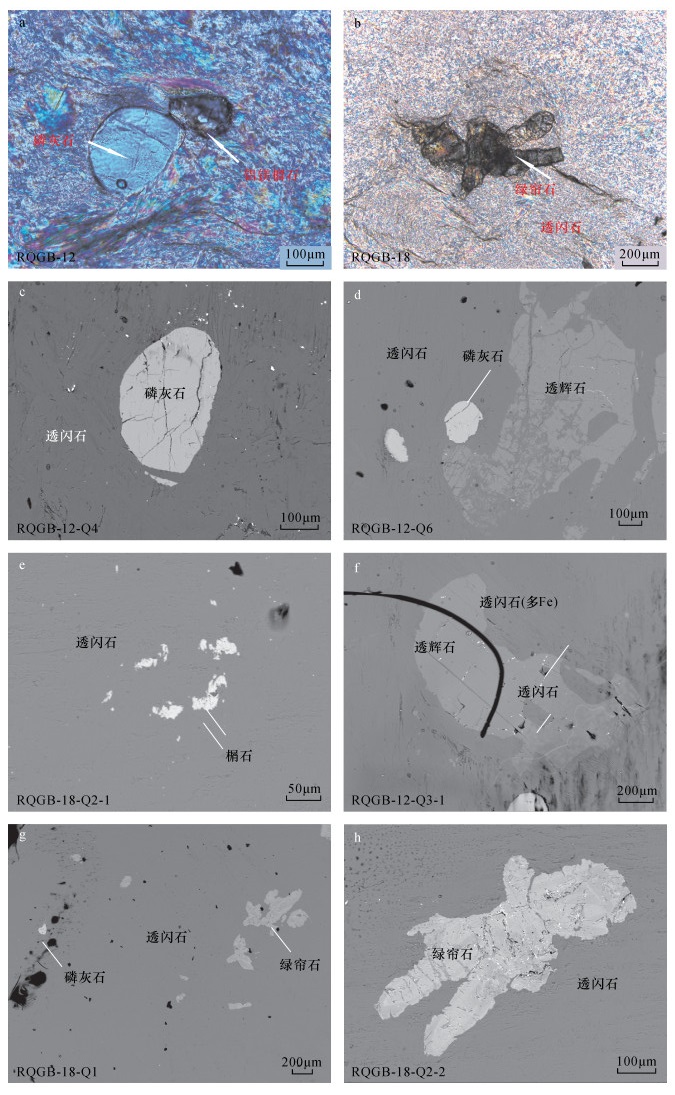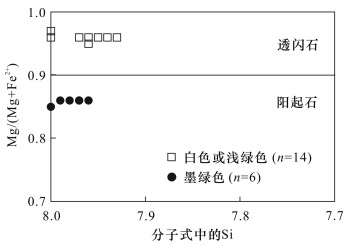| [1] |
Simandl G J, Riveros C P, Schiarizza P.Nephrite (Jade) Deposits, Mount Ogden Area, Central British Columbia (NTS 093N 13W)[R].British Columbia Geology Survey, 1999: 339-347.
Google Scholar
|
| [2] |
Makepeace K, Simandl G J.Jade (Nephrite) in British Columbia, Canada[R].Program and Extended Abstracts for 37th Forum on the Geology of Indutrial Minerals, 2001: 209-210.
Google Scholar
|
| [3] |
Łapot W.Peculiar nephrite from the East Saian Mts (Siberia)[J].Mineralogia Polonica, 2004, 35:49-58.
Google Scholar
|
| [4] |
Yui T F, Kwon S T.Origin of a dolomite-related jade deposit at Chuncheon, Korea[J].Economic Geology, 2002, 97:593-601. doi: 10.2113/gsecongeo.97.3.593
CrossRef Google Scholar
|
| [5] |
Harlow G E, Sorensen S S.Jade (nephrite and jadeitite) and serpentinite:Metasomatic connections[J].International Geology Review, 2005, 47:113-146. doi: 10.2747/0020-6814.47.2.113
CrossRef Google Scholar
|
| [6] |
Liu Y, Deng J, Shi G H, et al.Chemical zone of nephrite in Almas, Xinjiang, China[J].Resource Geology, 2010, 60:249-259. doi: 10.1111/rge.2010.60.issue-3
CrossRef Google Scholar
|
| [7] |
Liu Y, Deng J, Shi G H, et al.Geochemistry and petrology of nephrite from Alamas, Xinjiang, NW China[J].Journal of Asian Earth Sciences, 2011, 42:440-451. doi: 10.1016/j.jseaes.2011.05.012
CrossRef Google Scholar
|
| [8] |
Liu Y, Deng J, Shi G H, et al.Geochemistry and petrogenesis of placer nephrite from Hetian, Xinjiang[J].Ore Geology Reviews, 2011, 41:122-132. doi: 10.1016/j.oregeorev.2011.07.004
CrossRef Google Scholar
|
| [9] |
于海燕, 阮青锋, 孙媛, 等.不同颜色青海软玉微观形貌和矿物组成特征[J].岩矿测试, 2018, 37(6):626-636.
Google Scholar
Yu H Y, Ruan Q F, Sun Y, et al.Micro-morphology and mineral composition of different color Qinghai nephrites[J].Rock and Mineral Analysis, 2018, 37(6):626-636.
Google Scholar
|
| [10] |
Ling X X, Schmädicke E, Li Q L, et al.Age determination of nephrite by in-situ SIMS U-Pb dating syngenetic titanite:A case study of the nephrite deposit from Luanchuan, Henan, China[J].Lithos, 2015, 220-223:289-299. doi: 10.1016/j.lithos.2015.02.019
CrossRef Google Scholar
|
| [11] |
Middleton A.JADE-Geology and Mineralogy[M]//O'Donoghue M.Gems.Oxford: Elsevier, 2006: 332-354.
Google Scholar
|
| [12] |
张蓓莉.系统宝石学[M].北京:地质出版社, 2006:365-374.
Google Scholar
Zhang B L.Systematic Gemmology[M].Beijing:Geological Publishing House, 2006:365-374.
Google Scholar
|
| [13] |
买托乎提·阿不都瓦衣提.和田玉戈壁料与仿戈壁料鉴定方法探讨[C]//中国珠宝首饰学术交流会论文集.北京: 中国珠宝玉石首饰行业协会, 2009: 157-159.
Google Scholar
Abuduwayiti M.Hetian Nephrite Occurring In the Gobi Desert and Their Imitation[C]//Proceedings of China Gems and Jewelry Academic Conference.Beijing: China Jewelry and Jade Jewelry Industry Association, 2009: 157-159.
Google Scholar
|
| [14] |
Friedman I.Deuterium content of natural waters and other substances[J].Geochimica et Cosmochimica Acta, 1953, 4:89-103. doi: 10.1016/0016-7037(53)90066-0
CrossRef Google Scholar
|
| [15] |
Black L P, Kamo S L, Allen C M, et al.TEMORA 1:A new zircon standard for Phanerozoic U-Pb geochronology[J].Chemical Geology, 2003, 200(1):155-170.
Google Scholar
|
| [16] |
Nasdala L, Hofmeister W, Norberg N, et al.Zircon M257-A homogeneous natural reference material for the ion microprobe U-Pb analysis of zircon[J].Geostandards and Geoanalytical Research, 2008, 32(3):247-265. doi: 10.1111/ggr.2008.32.issue-3
CrossRef Google Scholar
|
| [17] |
Compston W, Williams I S, Kirschvink J L, et al.Zircon U-Pb ages forthe Early Cambrian time-scale[J].Journal of the Geological Society, 1992, 149:171-184. doi: 10.1144/gsjgs.149.2.0171
CrossRef Google Scholar
|
| [18] |
Stern R A.High-resolution SIMS Determination of Ra-diogenic Tracer-Isotope Ratios in Minerals[C]//Cabri L J, Vaughan D J.Modern Approaches to Ore and Environmental Mineralogy.Mineralogical Association of Canada, 1998: 241-268.
Google Scholar
|
| [19] |
Ludwig K R.Squid 1.02: A User's Manual[M].Berkeley Geochronology Center Special Publication, 2001: 1-21.
Google Scholar
|
| [20] |
Ludwig K R.User's Manual for Isoplot 3.00: A Geo-chronological Toolkit for Microsoft Excel[M].Berkeley: Berkeley Geochronology Center Special Publication, 2003.
Google Scholar
|
| [21] |
Liu Y, Zhang R Q, Zhang Z Y, et al.Mineral inclusions and SHRIMP U-Pb dating of zircons from the Alamas nephrite and granodiorite:Implications for the genesis of a magnesian skarn deposit[J].Lithos, 2015, 212-215:128-144. doi: 10.1016/j.lithos.2014.11.002
CrossRef Google Scholar
|
| [22] |
Liu Y, Zhang R Q, Abuduwayiti M, et al.SHRIMP U-Pb zircon ages, mineral compositions and geochemistry of placer nephrite in the Yurungkash and Karakash River deposits, West Kunlun, Xinjiang, Northwest China:Implication for a magnesium skarn[J].Ore Geology Reviews, 2016, 72:699-727. doi: 10.1016/j.oregeorev.2015.08.023
CrossRef Google Scholar
|
| [23] |
Douglas J G.The study of Chinese archaic jades using non-destructive X-ray fluorescence spectroscopy[J].Acta Geologica Taiwanica, 1996, 32:43-54.
Google Scholar
|
| [24] |
Douglas J G.Exploring Issues of Geological Source for Jade Worked by Ancient Chinese Cultures with the Aid of X-ray Fluorescence[C]//Jett P.Scientific Study in the Field of Asian Art.London: Archetype Publications Ltd, 2003: 192-199.
Google Scholar
|
| [25] |
刘喜锋, 刘琰, 李自静, 等.新疆皮山镁质矽卡岩矿床(含糖玉)成因及锆石SHRIMP U-Pb定年[J].岩石矿物学杂志, 2017, 36(2):259-273. doi: 10.3969/j.issn.1000-6524.2017.02.010
CrossRef Google Scholar
Liu X F, Liu Y, Li Z J, et al.The genesis of Mg-skarn deposit (bearing brown nephrite) and its Ar-Ar dating of phlogopite and SHRIMP U-Pb dating of zircon, Pishan, Xinjiang[J].Acta Petrologica et Mineralogica, 2017, 36(2):259-273. doi: 10.3969/j.issn.1000-6524.2017.02.010
CrossRef Google Scholar
|
| [26] |
Ohmoto H.Stable isotope geochemistry of ore deposits[J].Reviews in Mineralogy and Geochemistry, 1986, 16(1):491-559.
Google Scholar
|
| [27] |
张勇, 魏华, 陆太进, 等.新疆奥米夏和田玉矿床成因及锆石LA-ICP-MS定年研究[J].岩矿测试, 2018, 37(6):695-704.
Google Scholar
Zhang Y, Wei H, Lu T J, et al.The genesis and LA-ICP-MS zircon ages of Omixia nephrite deposit, Xinjiang, China[J].Rock and Mineral Analysis, 2018, 37(6):695-704.
Google Scholar
|
| [28] |
Siqin B, Qian R, Zhuo S, et al.Glow discharge mass spectrometry studies on nephrite minerals formed by different metallogenic mechanisms and geological environments[J].International Journal of Mass Spectrometry, 2012, 309:206-211. doi: 10.1016/j.ijms.2011.10.003
CrossRef Google Scholar
|
| [29] |
Grapes R H, Yun S T.Geochemistry of a New Zealand nephrite weathering rind[J].New Zealand Journal of Geology and Geophysics, 2010, 53:413-426. doi: 10.1080/00288306.2010.514929
CrossRef Google Scholar
|
| [30] |
Kostov R I, Protochristov C, Stoyanov C, et al.Micro-PIXE geochemical fingerprinting of nephrite neolithic artifacts from Southwest Bulgaria[J].Geoarchaeology, 2012, 27:457-469. doi: 10.1002/gea.21417
CrossRef Google Scholar
|
| [31] |
Adamo I, Bocchio R.Nephrite jade from Val Malenco, Italy:Review and update[J].Gems and Gemology, 2013, 49:98-106.
Google Scholar
|
| [32] |
Bhattacharya A, Raith M, Hoernes S, et al.Geochemical evolution of the massif-type anorthosite complex at Bolangir in the Eastern Ghats belt of India[J].Journal of Petrology, 1998, 39(6):1169-1195. doi: 10.1093/petroj/39.6.1169
CrossRef Google Scholar
|
| [33] |
James O B, Floss C, McGee J J.Rare earth element variations resulting from inversion of pigeonite and subsolidus reequilibration in Lunar ferroan anorthosites[J].Geochimica et Cosmochimica Acta, 2002, 66(7):1269-1284. doi: 10.1016/S0016-7037(01)00772-4
CrossRef Google Scholar
|
| [34] |
Charlier B, Auwera J V, Duchesne J C.Geochemistry of cumulates from the Bjerkreim-Sokndal layered intrusion (S.Norway):Part Ⅱ.REE and the trapped liquid fraction[J].Lithos, 2005, 83(3):255-276.
Google Scholar
|
| [35] |
刘喜锋, 张红清, 刘琰, 等.世界范围内代表性碧玉的矿物特征和成因研究[J].岩矿测试, 2018, 37(5):479-489.
Google Scholar
Liu X F, Zhang H Q, Liu Y, et al.Mineralogical characteristics and genesis of green nephrite from the world[J].Rock and Mineral Analysis, 2018, 37(5):479-489.
Google Scholar
|







 DownLoad:
DownLoad:
